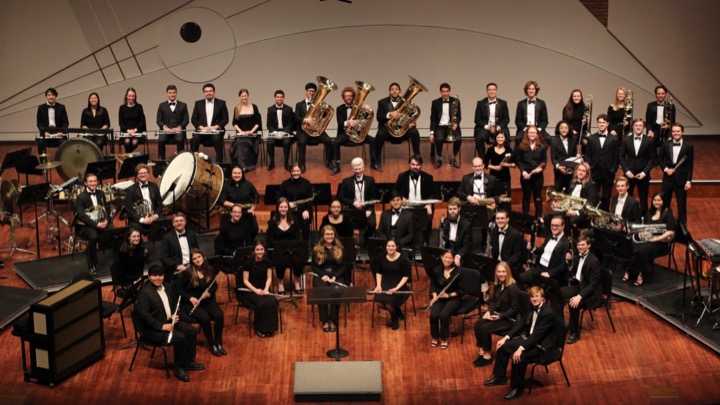
In this section:
Perhaps a better title for this page is "How To Study Your Instrument." The concept of study always means thinking, which is the most important aspect of practicing. The mind should be engaged at all times when practicing, which means that you should have definite goals as to what it is you want to accomplish before you enter the practice room. Just putting in time, however, is usually a waste of time. Musicians must practice not only to develop their musical mind but to condition their bodies. Artur Rubinstein said, "If I miss one day of practice, I know it. If I miss two days, my audience knows it." It was not so much that his mind began to forget, but it was his fingers, hands and arms that began very quickly to lose their touch.
First it is important that you realize the importance of spending time playing your instrument away from all other musicians so that you can hear just how you sound. With individual practice, you will be able to move forward in ways that are impossible in full ensemble rehearsal.
Next it is important that you develop a reasonable schedule for practice that is compatible with the many other demands that are being placed on your time. Be honest with yourself and realize that you are not really a functional instrumental musician unless you are practicing on a regular basis.
Develop a structured routine for practice. This will help you maximize your valuable time and will make the time spent more fun and fulfilling. Several 30-minute sessions in a day are better than a 3-hour marathon practice session. Remember: if you're not practicing, somewhere, your competition is!
Here is a suggested routine for wind players, which may be easily adapted for percussionists:
Warm-Up
- Long Tones
Playing long tones without looking at the printed page will allow you to hear yourself and make the small embouchure adjustments that are necessary to achieving the ultimate resonance that is possible on your instrument. Long tone will build breath support and improve your range. When using long tones to "warm up", play in mid-range at about mf. - Lip Slurs (brass only)
After warm-up and long tones, brass players should spend some time slurring up and down the instrument without the use of valves or tongue, just embouchure movement and a steady flow of air. There are many written out flexibility studies, but it is also fun to develop your own. - Scales for manual dexterity and articulation
Scale study is important, because it is part of the structure used by composers to write melodies, etc. Scale study will greatly improve your ability to sight-read. There are 84 diatonic scales (105 on paper). In addition, there is the chromatic scale, the whole tone scale, the blues scale, the pentatonic scale, and scales that composers develop on their own. You should have both short and long term goals for mastering scales. It is best to learn scales by "ear" as well as spending time playing scale exercises. Use varying articulations (staccato, slur-two tongue-two, double tongue, etc.) to prepare for styles needed in the literature that follows.
Literature
- Etudes
- Etudes are musical studies that are designed to aid an instrumental musician in the development of his/her mechanical and technical ability. An etude is usually devoted entirely to one of the special problems of instrumental technique, such as scales, arpeggios, octaves, trills, etc. It is important that each member of the Cal Poly Band program owns a "method book" for his or her instrument. For example, each trumpet player should own a copy of the Complete Conservatory Method for Trumpet by J. B. Arban. Method books are fun and will provide hours of challenge and enjoyment in the practice room. Such method books can be found at most music stores.
- Solos
- Each musician should spend time preparing a solo piece that has piano accompaniment. This is a great deal of fun and will be highly motivational.
- Excerpts for the next ensemble rehearsal
- During rehearsals identify what passages in the music need work and have them mastered by the next rehearsal. In your practice, focus on the phrases that need the attention. One must not arrive at a rehearsal unprepared. Ensemble rehearsal is where individual practice and effort contributes to the group experience.
Improvisation
Each musician should spend some time at each practice session "playing by ear." Jazz musicians must develop the fine art of jazz improvisation, but classical musicians must also learn to be creative by playing tunes that you know or make up yourself without looking at the printed page. This is a powerful musical process. It will open your mind and greatly sensitize your ears.
Here are some suggestions as to how to learn difficult passages:
- Divide the passage into several small musically logical fragments or "chunks." Using the "divide and conquer" approach, practice each fragment until you have it. Then begin the process of putting all the fragments together to make a unified musical thought. Try building the larger excerpt from the end, adding earlier fragments with every successful repetition.
- Practice at the tempo that you can play all of the notes correctly, in rhythm, in tune, and with expression. Don't speed up when it's easy and slow down when it's difficult. Using a metronome, determine what tempo you used. On the next run through, move the metronome to a faster speed, but no faster than you can perform the excerpt correctly. Keep this process up until you reach the correct tempo. Even if you haven't achieved the ideal tempo in that practice session, always leave an excerpt after having played it successfully at a steady tempo.
- In rapid passages of 4 notes to a beat with difficult fingerings, set the metronome on a tempo just a little slower than marked. Then play only the first note of each beat with the metronome. Next, play only the first and third notes. Then play only the first three notes, and finally play all of the notes. Move the metronome up and soon you will have it.
- Break up the phrase into its fundamental elements:
- Sing the phrase to get the music in your ear.
- "Air" the phrase to find the proper flow and continuity.
- "Technique" the phrase to focus the rhythm of the fingers.
- Slur the entire phrase.
- Add required articulations to the phrase.
A Daily Practice Routine
(from Alex Iles' masterclass hosted at Cal Poly, May 2009)
I. Away from the Horn
- Breath, posture
- Buzzing, ears, singing
Usually part of a thorough warm-up, these can also be used to check and stretch the basic mechanics used to create sound on our instrument.
II. On-horn Fundamentals
- Sound/Intonation
- Time/Rhythm
- Flexibilty/Articulation
- Reading/Ear Play Part 1
- Upper/Lower extremes
- Rest & Water
The most important element of practice, fundamentals are the building blocks for successful musical performance. A player with solid fundamentals has at their disposal the skills necessary to read and perform at a high level in any musical context: solo, chamber music and large ensemble playing.
III. Mining for Music
- Etudes, Solos, Parts
- Tunes (Ear Play Part 2)
- Improvisation
- Composition
- Focused Listening (with the horn)
Here, the fundamentals are applied and reinforced. Etudes will exercise specific skills in the context of a formal piece of music. Playing tunes, written and as improvisation, invite expressive playing: as Bud Herseth says, "Never practice, always perform."
IV. Input
- Concerts and Recordings
- Rehearsing/Sight-reading
- Books/Periodicals
- Organizations/Guilds
This can be done any time away from the instrument but also can be used to fill in the rests during a practice session. Listen to a recording of a favorite musician, read an article about reed making, or listen to music by an unfamiliar composer.
Back to handbook table of contentsBack to resourcesBack to top

